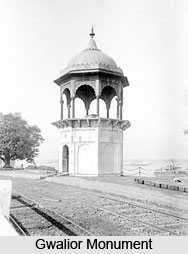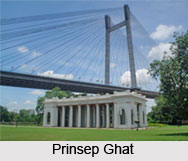 Gwalior Monument, which is also known as Ellenborough"s Folly or Pepperpot is located in Kolkata. This monument was erected adjacent to Prinsep Ghat, one of the leisure tourism spots in the capital city of West Bengal-Kolkata.
Gwalior Monument, which is also known as Ellenborough"s Folly or Pepperpot is located in Kolkata. This monument was erected adjacent to Prinsep Ghat, one of the leisure tourism spots in the capital city of West Bengal-Kolkata.
History of Gwalior Monument
Gwalior Monument, also known as Ellenborough"s Folly, or The Pepperpot, is an octagonal cenotaph which is about 60 feet high. This monument is crowned with a bronze dome cast from guns captured from the Maratha Empire of Gwalior. Gwalior Monument was erected in 1847 by Lord Ellenborough, the Governor-General of India on behalf of British East India Company. It acts as a memorial to the officers and men who fell during the Gwalior War in the year 1843. On December 13, 1843 Lord Elleborough wrote to the Maharani of Gwalior warning her that she should dismiss a usurping regent and that the size of her army should be reduced. Since she did not comply, the Gwalior Invasion took place by the armies of British East India Company.
 General Sir Hugh Gough violated the treaty of 1804 with Gwalior Empire, forded the Chambal River and invaded the town of Gwalior, Madhya Pradesh, which was known for its palaces on December 29, 1843. The Gwalior War at Maharajpur was fought under Sir Hugh had 14,000 men and 40 guns. The Marathas under Bhagerat Rao Scindia had 18,000 men and 100 guns. The British routed the Mahrathas but suffered 787 casualties. The Mahrathas lost 3000 men and 56 guns. On the same day at Punniar, 20 miles from Maharajpur, the left flank of troops of the General under General Grey routed an army of 12,000 Marathas and captured 40 guns.
General Sir Hugh Gough violated the treaty of 1804 with Gwalior Empire, forded the Chambal River and invaded the town of Gwalior, Madhya Pradesh, which was known for its palaces on December 29, 1843. The Gwalior War at Maharajpur was fought under Sir Hugh had 14,000 men and 40 guns. The Marathas under Bhagerat Rao Scindia had 18,000 men and 100 guns. The British routed the Mahrathas but suffered 787 casualties. The Mahrathas lost 3000 men and 56 guns. On the same day at Punniar, 20 miles from Maharajpur, the left flank of troops of the General under General Grey routed an army of 12,000 Marathas and captured 40 guns.
Architecture of Gwalior Monument
Gwalior Monument was designed by Colonel H Goodwyn of the Bengal Engineers and constructed by Jessop and Company. It was conceptualised by Lord Ellenborough. The base of Gwalior Monument is a single storied white marble structure with a spiral staircase leading to a marble cenotaph on the upper floor from the inside. The top of the Gwalior Monument is built like a Mughal “chhatri†or umbrella supported by 8 bronze pillars. The dome of the Gwalior Monument is crowned with a bronze dome cast from guns captured from the Marathas.
Tourism near Gwalior Monument
Gwalior Monument shows the majestic beauty of colonial history. And from the Gwalior Monument, one can see the beauty of Ganges in the dusk. Hoogly River can be seen along with the full view of Vidyasagar Setu. The Kolkata Circular Railway passes along the memorial between the Eden Gardens and Prinsep Ghat railway stations and gives a spectacular view of this Gwalior Monument.



















